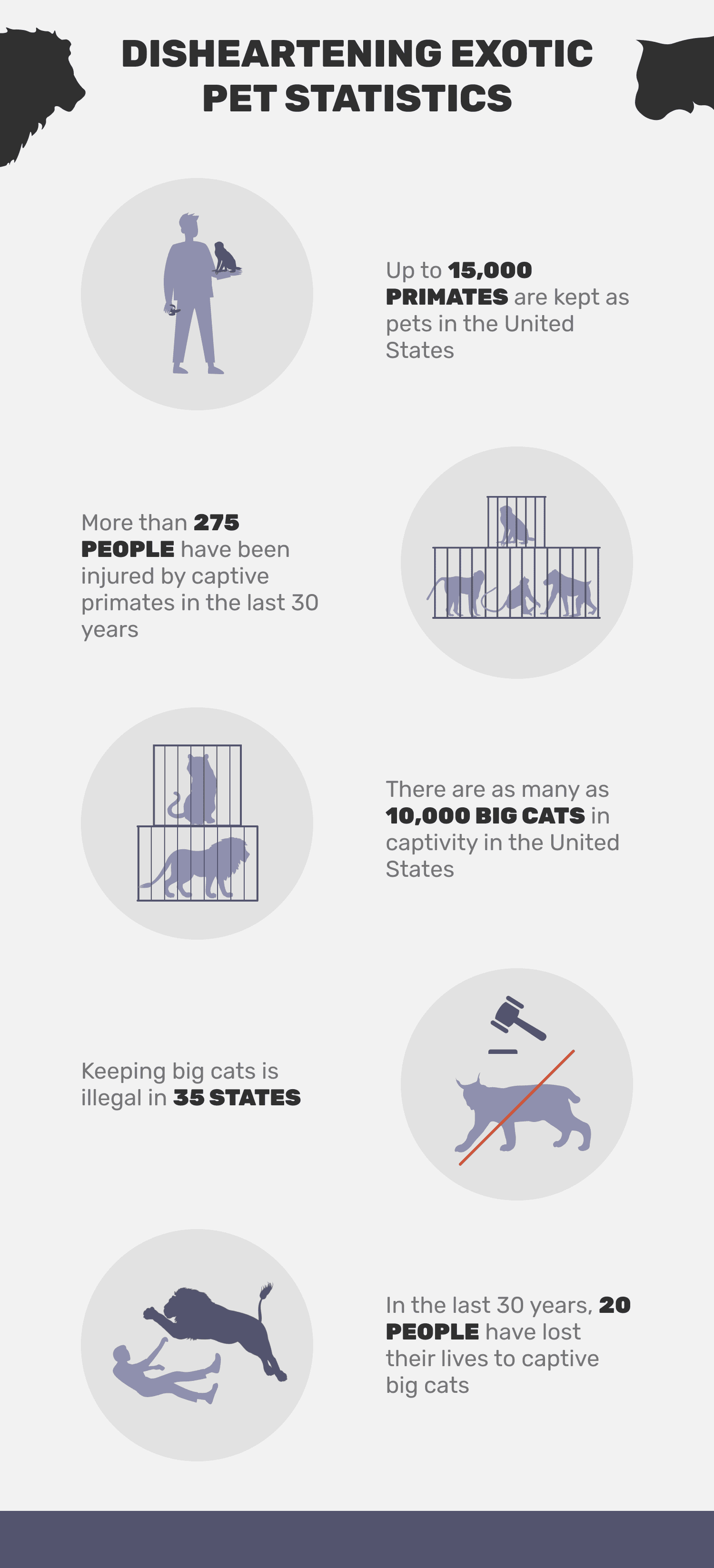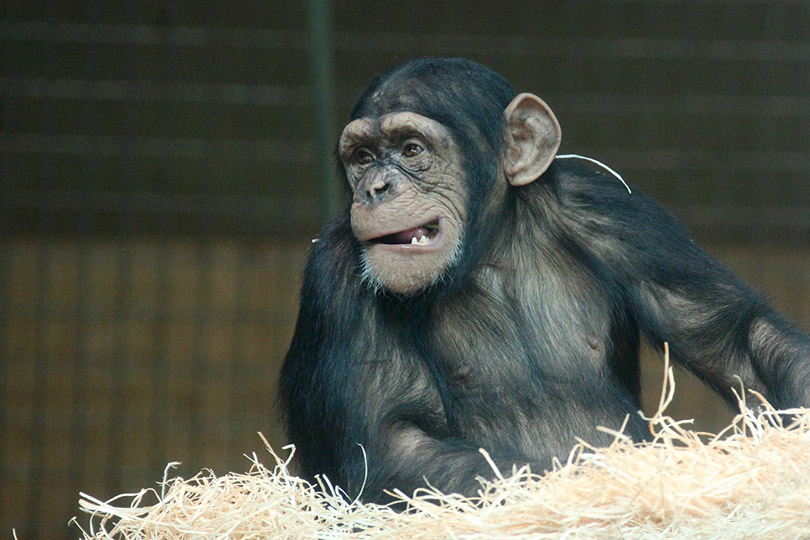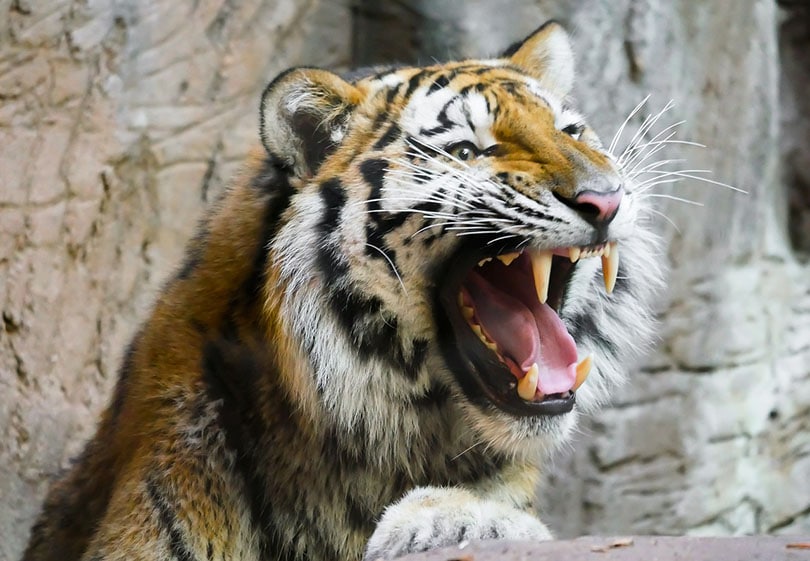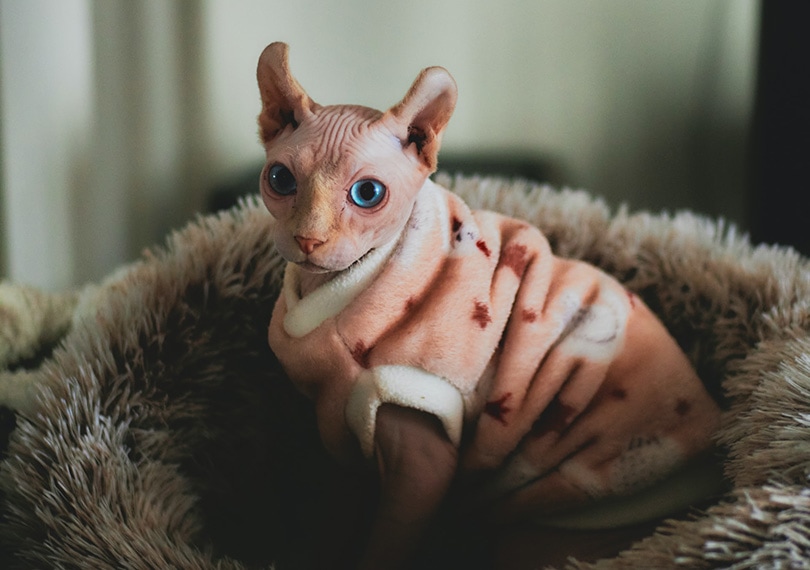
Click to Skip Ahead
Note: This article’s statistics come from third-party sources and do not represent the opinions of this website.
We can’t deny that baby wild animals are precious. The idea of keeping a wild animal as a pet can be exciting. Wild animals, however, can grow up to be dangerous and unpredictable. The sweetest baby monkey or tiger cub will grow up to be an adult that can give you a nasty bite or scratch—or much worse. There are frequent news reports about wild animals who have been kept as pets attacking and injuring people, sometimes fatally.
We have compiled the most crucial information about ownership and attacks for primates and big cats to help you better understand the dangers of keeping exotic pets. Here is what you need to know.
Top 11 Exotic Pets Statistics
- Up to 15,000 primates are kept as pets in the United States.
- More than 275 people have been injured by captive primates in the last 30 years.
- Up to 100 chimpanzees are kept as pets in the United States.
- There have been more than 47 incidents involving captive chimpanzees in the US since 1990.
- The first person to receive a double hand and face transplant was mauled by a pet chimpanzee.
- So far in 2021, only one pet chimpanzee has been shot dead by police in the US.
- There are as many as 10,000 big cats in captivity in the US.
- Keeping big cats is illegal in 35 states.
- There have been at least 523 incidents involving captive big cats since 1990.
- In the last 30 years, 20 people have lost their lives to captive big cats.
- There was only one leopard mauling in Florida in 2020.

 Ownership & Attack Statistics for Primates
Ownership & Attack Statistics for Primates
1. Up to 15,000 primates are kept as pets in the United States.
(National Geographic)
As many as 15,000 primates are kept as pets in the United States, according to the Allied Effort to Save Other Primates, an international alliance of individuals and organizations dedicated to protecting apes and monkeys. In situations where primates are kept as pets, their complex physical, psychological, and social needs cannot be met. Pet primates are taken from their mothers when they are only a few hours or days old and raised in deprived and unsuitable environments. Many of these animals grow into mentally disturbed adults with self-destructive and neurotic behaviors.

2. More than 275 people have been injured by captive primates in the last 30 years.
(The Humane Society)
Although it is likely that many incidents go unreported, records show that scores of children are among the hundreds of people who have been attacked and injured by pet primates in the past thirty years. Pet primates have attacked and injured youngsters in many situations—as they played outdoors, on visits to local parks, when walking their dogs, or while out shopping. In the wake of these traumatizing incidents, children have suffered bite wounds that penetrated to the bone, lost fingers, undergone painful rabies treatments, and tested positive for the deadly Herpes B virus. In fact, one woman died after contracting Herpes B from a macaque.
3. Up to 100 chimpanzees are kept as pets in the United States.
(Arcus Foundation)
There are an estimated 100 chimpanzees kept as pets or held by breeders or dealers in the United States. There may be nothing cuter than a baby chimpanzee. Infant chimpanzees are affectionate, playful, and enjoyable to interact with. However, this cuteness soon gives way to danger. Chimpanzees are stronger than the average adult human by age five. By this time, they often become destructive and disobedient. It is difficult to keep chimpanzees stimulated and satisfied in a human environment because they grow up fast and are ferociously intelligent. Given their cleverness and rebelliousness, it is not uncommon for them to bite. This is why many chimpanzee owners have suffered severe injuries to their fingers and faces.
4. There have been more than 47 incidents involving captive chimpanzees in the US since 1990.
(Born Free USA)
While many of the incidents concerning captive chimpanzees related to animals kept by zoos and other facilities, many others involve primates kept as pets. Each chimpanzee is a unique individual. However, chimpanzees are known to bite each other in the wild and aggression is a natural part of their behavior. No matter how much an owner loves their chimp, chimpanzees are simply too dangerous to keep as pets. Unfortunately, once domesticated they cannot be returned to Africa. Ex-pet chimpanzees are usually not accepted by zoos, since they aren’t accustomed to chimpanzee etiquette and tend not to fit into established groups. If they cannot find a place in a sanctuary, sadly, many ex-pet chimps are used for medical research.

5. The first person to receive a double hand and face transplant was mauled by a pet chimpanzee.
(ABC News)
In 2009, Sandra Herold asked her friend Charla Nash for assistance in caging her 200-pound chimpanzee, Travis. Travis was a pet and an actor. He had featured in many TV shows and advertisements. Before attempting to move Travis, Herold had drugged him with anti-anxiety medication. Instead of making the chimpanzee docile, it may have made him more aggressive. Nash was brutally attacked by Travis, who mauled her face and hands with his teeth and strong hands. Herold stabbed Travis with a kitchen knife as she attempted to rescue Nash. Fifty-five year old Charla Nash’s injuries were horrific and extensive—she became the first person to ever receive a double hand and face transplant. Connecticut officials declined to prosecute Herold. Although Nash’s family had a $50 million civil suit pending when Herold died of a ruptured aortic aneurysm in 2010, the Nash family has since settled out of court for $4 million.
6. So far in 2022, only one pet chimpanzee has been shot dead by police in the US.
(NBC News)
In June 2021 in northeast Oregon, a sheriff’s deputy shot and killed a pet chimpanzee at owner Tamara Brogoitti’s desperate request. Buck, a male adult chimp, had lived with the Brogoitti family for about 17 years. Although in 2010, chimpanzees and other exotic animals were banned as pets in Oregon, Brogoitti had a permit to own Buck from before that time and the primate was living at her home legally. He had been deeply loved by the family and was well known in the community, having accompanied his Tamara Brogoitti on errands around town when he was younger. After he escaped from his outdoor cage, Brogoitti’s 50-year-old daughter was attacked by Buck. He lacerated her torso, arms, and legs several times. The Brogoittis could not restrain Buck. Police were called to their home, and Buck was fatally shot with one round to the head.
 Ownership & Attack Statistics for Big Cats
Ownership & Attack Statistics for Big Cats
7. There are as many as 10,000 big cats in captivity in the US.
(International Fund for Animal Welfare)
The United States has no official record of all big cats kept in captivity. This is because there is no government agency responsible for tracking the ownership and sale of privately owned exotic animals. The captive big cat population in the US is estimated to be up to 10,000 animals, and the captive tiger population at up to 7,000. Private ownership of big cats in the U.S. is currently not regulated by federal law. As a result, numerous unwanted and unhealthy big cats have been produced because of uncontrolled breeding. In captivity, many big cats suffer from shrunken hearts, shortened tendons, club feet, kidney ailments, deformed faces, and contorted necks. In addition, the lack of regulation makes it very difficult to track their distribution and populations.

8. Keeping big cats is illegal in 35 states.
(Big Cat Rescue)
The majority of states ban big cats as pets, and some require permits, however, some others have no restrictions at all. As a result of the fragmented system of state laws, big cats have been exploited, abused, and illegally traded across state lines. In total, 35 states ban keeping big cats as pets, with various exceptions, regulations, and levels of enforcement. Six states have no laws against keeping big cats: Alabama, Nevada, North Carolina, Wisconsin, Delaware, and Oklahoma. That is in spite of all of the evidence indicating that keeping animals captive can be extremely dangerous to the animals, and to the people in their vicinity.
9. There have been at least 523 incidents involving captive big cats since 1990.
(Born Free USA)
The numbers tracked by Born Free USA may be skewed to the lower side, since incidents at zoos are much more likely to be publicly reported than incidents involving pets. Especially if they keep their animals secretly, owners may be inclined to hide incidents and accidents. Big cats in captivity require special diets, exercise, as well as opportunities to express their natural instincts. Captive carnivores have significantly higher levels of stress and frustration than their wild counterparts. However long a big cat has been in a cage, they are still predators, and it isn’t always humans that bear the brunt of their aggression. For example, a 275-pound pet cougar escaped from his cage in Florida in May 2012 and killed a neighbor’s dog that wandered onto the property. Even hand-raised big cats are still genetically wild animals.
10. In the last 30 years, 20 people have lost their lives to captive big cats.
(The Humane Society)
Since 1990, because of captive big cats, four children have lost their lives and dozens have suffered limb loss or other serious injuries. In addition, 16 adults have been killed and dozens more have been mauled. For example, in Texas, in 2011, a 4-year-old boy was attacked and mauled by the 150-pound pet cougar of Amber Michelle Couch, a relative. The animal control department had previously issued Couch citations related to her 150-pound pet cougar. Her pet’s vaccinations were out-of-date, and his cage was too small. Furthermore, the gaps between the bars were too wide, posing a safety hazard for anyone who approached close to them. Which is exactly what happened when the child got too close to the cage. The cougar slid a paw through the gaps, slashing the child’s face and the left side of his body. The traumatic incident left the boy with significant injuries, although he survived. The cougar, however, was seized and euthanized by animal control officials.

11. There was only one leopard mauling in Florida in 2020.
(Florida Fish and Wildlife Conservation Commission)
At the end of August of 2020, Dwight Turner paid $150 to get in a cage with a black leopard at the house of animal dealer Michael Poggi in Florida. Turner was supposed to enjoy a “full-contact experience” with the leopard; rubbing its belly and taking selfies with it. Instead, the leopard attacked almost immediately, ripping his right ear in half with its teeth and tearing into his head. Turner’s wife had to press and hold the dangling flap of his scalp back in place. He had to undergo two surgeries and had 22 staples inserted into his scalp. There is still a chance that he may lose his right ear.
Frequently Asked Questions
How Many People Get Killed by Exotic Pets?
(Born Free USA)
Since 1990, Born Free USA, a nonprofit advocacy organization that strives to end the ownership of wild animals, has documented some 662 attacks involving exotic pets, which resulted in human injury, including 91 human deaths.
What Pet Kills the Most Owners?
(Dogsbite)
If you’re expecting to see an exotic pet listed here, think again. A study by Dogsbite shows that Pit Bulls continue to be responsible for the most fatal attacks in the U.S., killing 284 people between 2005 and 2017. This is even though the breed only accounts for 6.5% of all U.S. dogs.

What Are the Dangers of Owning an Exotic Pet?
(Paws.org)
Throughout millions of years, wild animals have evolved into independent, free-living beings. Biologically, their needs, instincts, and behaviors are inextricably bound to both an appropriate habitat and a free-living state. Forcing a wild animal to live a captive life is inhumane. It is likely that they will become nuisances in their behaviors or outright dangers to human life. If we truly love wild things, we must leave them in wild places.
Conclusion
Although there is greater public awareness of the dangers of keeping exotic pets, the problem persists. Exotic pets belong in the wild, not confined in small spaces or unsuitable environments. as pets. As consumers, it’s up to us to eliminate demand. We must not buy or interact with exotic pets. If there is no demand, there will be no trade. Let’s come together and do what we can to end the suffering of our animal friends.
Related Reads:
- Disheartening Animal Testing Statistics in The UK
- Disheartening Australian Animals in Captivity Statistics to Know
Featured Image Credit: Gansstock, Shutterstock






